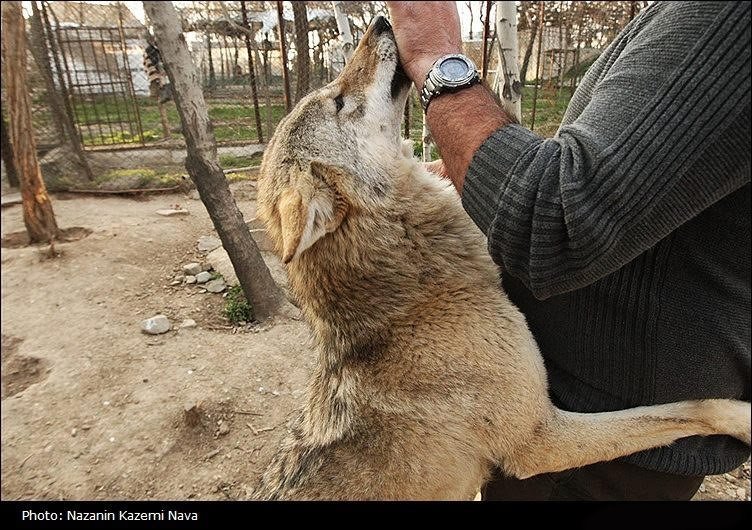Wolves’ precarious future in Iran

Over the last two weeks, two children from Zanjan Province were attacked by wolves. On 13 May one of these wolves was shot dead. This is the sad story of wolves in Iran. Wherever wolves come into contact with people, the animals are regarded as dangerous pests who will- given the chance- kill people and livestock. They are poisoned, trapped and shot not only for their conviction, but also for human fear.
The picture depicts how a wolf, named Termeh, is raised in human care. In the picture one can easily spot the wolf’s great passion to its vet. Chief vet of Pardisan Rehabilitation Center Dr. Iman Memarian and his fellow, Alireza Shahrdari raised Termeh when she lost her parent. In general, it is against the law to keep a wolf as a pet. But the story of Termeh is the story of other wolves in Iran. Much of the land where these animals once lived is now being farmed and destroyed by humans. Their present range shows they have been exterminated in most parts of the country, almost all of their territory come into contact with people, and it seems there is absolutely no chance for them to survive.
Effects of wolves’ disappearance
Wolves were once the most widespread carnivores in the northern hemisphere. Now they survive in a much reduced area, often in small, scattered groups. Wolves may be powerful predators, but they face many threats in the wild.
Wolves are also threatened when their habitats are disturbed or destroyed. In many areas of Iran, the territories where wolves can roam freely are getting smaller and smaller. Land is needed for crops or to graze herds of sheep and cattle. Forests are cut down for timber or to make way for new roads and towns. Farmers have built fences across many parts to keep wolves out, any wolf caught inside the fence is shot. We just want to ask, is everything for human being?
The survival of wolves is also threatened by deadly diseases, such as distemper, anthrax and rabies. And unfortunately lack of knowledge is getting greater and greater. Wolves normally hunt old, young, weak, or disabled prey and soon give up an attack if the animal or prey is able to defend itself or make a quick getaway. In fact, only about 8 percent of wolf hunts end in a kill, which is why it is highly unlikely that wolf predation does any real harm to prey populations as was once feared.
A large wolf needs to eat an average of 2.5 kg of meat every day, but will often go for several days without food. Wolves are apex predators. Apex predators have a great role in a healthy environment. Loss of apex predators end in collapse of the ecosystem. A new study said: “The catastrophic decline around the world of "apex" predators such as wolves has led to a huge increase in smaller "mesopredators" that are causing major economic and ecological disruptions.”
Virtually incapable of defending themselves
Wolves are the wild members of the dog family, canids, with gleaming yellow eyes and lean, muscular bodies. The 37 different species of canids include wolves, jackals, coyotes, foxes and etc. Canids are native to every continent except Australia and Antarctica. All of them share a keen sense of smell and hearing and are carnivores. Wolves hunt live prey, which they kill with their sharp teeth. However, when a kill is made, it makes up for any such lean periods by wolfing up to 9 kg in a single meal. A large prey animal may keep a pack well fed for several days. During the time they are not actively feeding, the wolves may rest near the carcass to defend it from scavengers.
But wolf attacks on humans are rare. There are no fully documented cases of unprovoked attacks on people by healthy wolves. However, wolves can and do attack livestock. Sheep and cattle are, after all, close relatives of the wolf’s natural prey and yet far easier to catch and kill because generations of domestication have made them virtually incapable of defending themselves. They are large, meaty, and prone to panic, and are often penned in with no hope of escape. Even so, it would rarely take more than the sight of a human to cause the wolves to abandon the hunt and run away.
Habitat shrinking
The pack occupies a territory of anything from 20 to 13.000 sq. km, the exact size varying according to the number of wolves and quality of habitat. The dominant (or alpha) is responsible for initiating hunts or other movements. But sick and old wolves may cause danger such as attacking to livestock, etc. The wolf is the largest species in this family (Canidae). It ranges widely in every Iranian province and appears in two differently colored races. In most regions in northern half of the country, it is large and usually gray which resembles a European Wolf. The other form is smaller and colored buff yellow, darkening to brown towards the spine and head. According to the book of complete fauna of Iran this race has been seen in northwest, central and southwest Iran.
The wolves in Iran are not seriously endangered. However, the expansion of cities and intensification of farming have resulted in habitat loss. Although some wolves manage to live close to farms and on the edges of towns but in fact they have become scarcer. Remaining populations are widely separated and these threats are harmful because if we lose wolves, there would be no solution for controlling the population of herbivores and this may end in increasing disease, and so on.
Leave a Comment